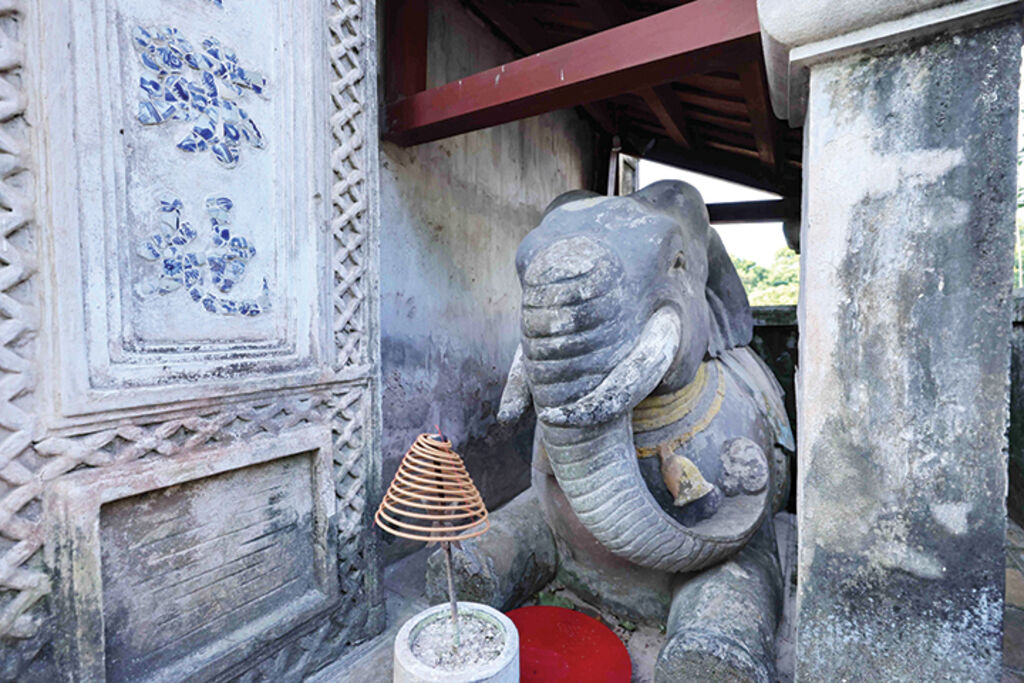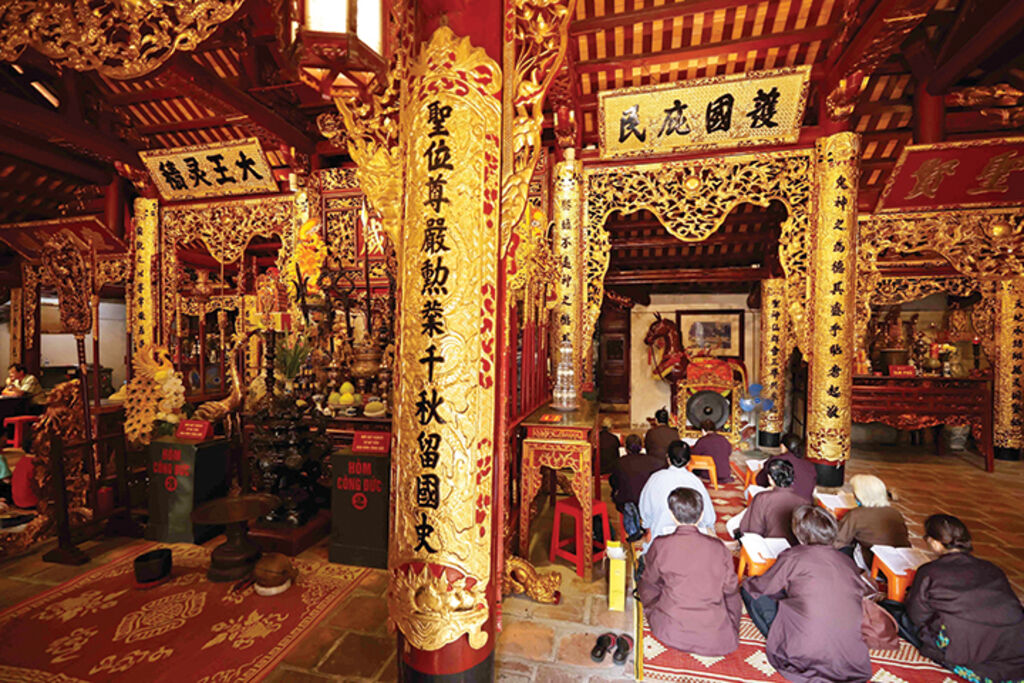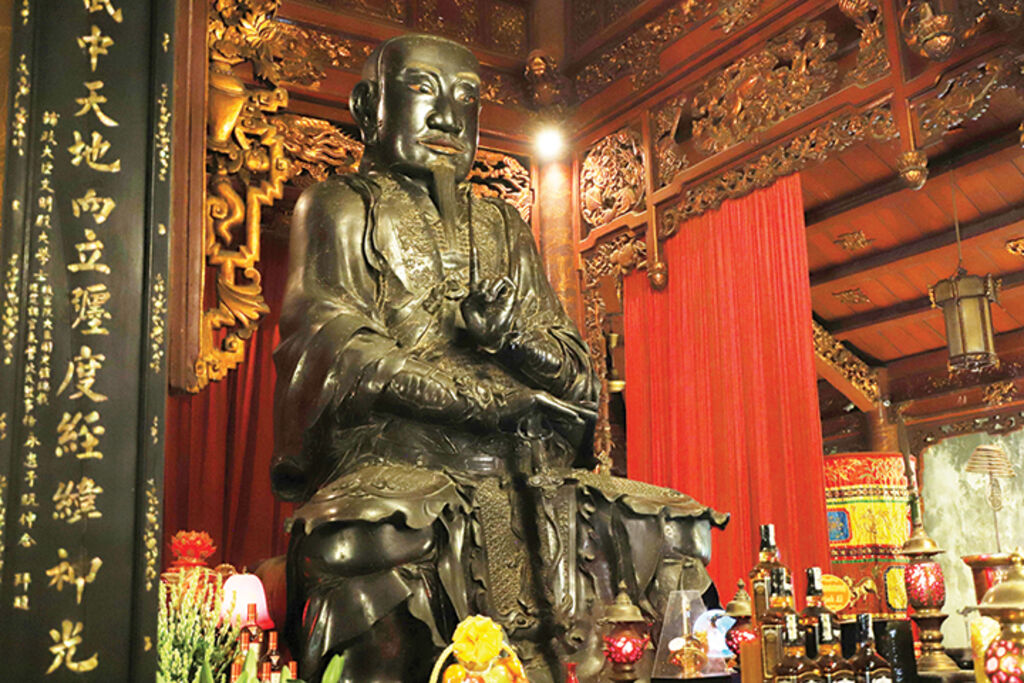 |
| White horse statue at Bach Ma Temple__Photo: VNA |
Thang Long Tu Tran were established very early, closely associated with the founding of Thang Long Capital (now the inner city of Hanoi) under the Ly dynasty. It refers to the four most sacred guardian temples of the ancient capital, including Bach Ma temple, Voi Phuc temple, Kim Lien temple and Quan Thanh temple.
With their profound historical and cultural significance, in 2022, the Prime Minister signed Decision 93/QD-TTg, recognizing Thang Long Tu Tran as a special national relic, alongside four other sites across the country.
Thang Long Tu Tran were built in four cardinal directions (East, West, South and North) of the ancient Thang Long capital, forming a protective circle.
According to folk beliefs, this arrangement creates balance in terms of feng shui, reflecting the ancient Vietnamese’s view of the universe and the harmony between humans and nature.
Each of the four temples is also associated with legends about the construction and defense of the ancient Thang Long capital, implying that Tu Tran are not merely four separate temples, but rather a unified whole. They also embody the spirit of solidarity and collective strength of the Vietnamese people in defending the country.
Legends of the guardian temples
Bach Ma temple
Located in the East, Bach Ma (White Horse) temple was first erected in 866 in Tho Xương district, Hoai Duc prefecture (now in Hang Buom street). The temple is dedicated to Long Do (a guardian deity), safeguarding the livelihood and well-being of residents in the capital and protecting the capital itself. It was later rebuilt during the Ly dynasty after 1010, making it the oldest temple among Thang Long Tu Tran.
Legend has it that when King Ly Thai To moved the capital to Thang Long in 1010, the citadel walls kept collapsing during construction. The King prayed at the temple, and a white horse appeared, leaving its hoofprints along the ground before returning inside. The King then ordered the citadel to be built following the horse’s tracks, and it was successfully completed. Since then, the temple was named Bach Ma.
Throughout the Ly, Tran and Le dynasties, with 52 kings ruling in the ancient Thang Long capital, Bach Ma temple witnessed the capital’s vicissitudes. At present, Bach Ma temple still has the Nguyen dynasty’s architectural style and preserves valuable artifacts, such as steles recording anecdotes and myths about the construction of the temple, rituals dedicated to Long Do deity as well as its restorations over more than a millennium. Other relics include royal decrees, incense altars, vases, bronze bells, ceremonial palanquins, etc.
Voi Phuc temple
Voi Phuc temple was built in Thu Le village to the west of the ancient Thang Long capital (now Ngoc Khanh ward). Its name, which means prostrating elephants, derives from the two kneeling elephant statues standing at its entrance.
 |
| Kneeling elephant statue at Voi Phuc Temple__Photo: VNA |
Constructed in 1065 by King Ly Thanh Tong to worship his son, Prince Linh Lang, who made great contributions to the resistance against the Song dynasty’s invasion and sacrificed with courage. The temple later gained further reverence during the Tran dynasty, when the prince was believed to aid the royal troops in repelling two Mongol invasions.
The temple houses splendid gilded horizontal lacquered boards and parallel sentences in Han (ancient Chinese) characters, extolling the deity’s virtue and sacredness. It was officially recognized as a national historical and cultural relic in 1962.
Kim Lien temple
Kim Lien temple was first built during the Ly dynasty in Kim Hoa village (now Kim Lien ward). It is dedicated to Cao Son Dai Vuong (Cao Son deity), a guardian deity believed to protect the people against disasters and foreign enemies, maintaining peace and prosperity. According to legend, Cao Son deity was a son of Lac Long Quan and Au Co, who are believed the ancestors of the Vietnamese nation, one of the 50 children who followed their mother to the mountains. Later, he chose to settle and cultivate the land in the village. After his passing, villagers built the temple in his honor.
 |
| Interior view of Kim Lien Temple__Photo: VNA |
Historical records at the temple indicate that King Ly Thai To ordered its reconstruction shortly after establishing the Thang Long capital in 1010, as a protective shrine in the South. Despite historical upheavals, Kim Lien temple has been kept in its original state. It preserves valuable relics, including 33 royal decrees from the Le and Nguyen dynasties, and the stone stele Cao Son Dai Vuong Than Tu Bi Minh (inscription of the deeds of Cao Son deity) made in 1510. These treasures not only provide crucial historical records but also offer insights into calligraphy, linguistics and traditional Vietnamese art.
The temple was recognized as a national historical and cultural relic in 1990.
Quan Thanh temple
Nestled in the North, Quan Thanh temple was built in the early years of King Ly Thai To’s reign, in the northeastern shore of the West Lake (now Quan Thanh ward). In 1823, King Minh Mang renamed it Tran Vu Quan (Tran Vu shrine), and in 1842, King Thieu Tri gave it its present name, Quan Thanh temple.
 |
| Bronze statue of Huyen Thien Tran Vu deity at Quan Thanh Temple__Photo: VNA |
The temple is dedicated to Huyen Thien Tran Vu, the northern guardian deity believed to expel demons and evil spirits. At its center stands an imposing bronze statue of Huyen Thien Tran Vu deity with a height of 3.96 meters, 8-meter circumference and a weight of 4 tons. This masterpiece reflects the exceptional bronze-casting skills of Vietnamese artisans of the past. The temple also preserves many relics and antiquities of various types and materials from different historical periods such as stone steles and royal decrees, the earliest of which dates back to 1770.
Quan Thanh temple was recognized as a national historical and cultural relic in 1962. In 2016, the bronze statue was further honored as a national treasure, affirming the temple’s immense historical and artistic value.
Festivals at Thang Long Tu Tran
Each temple of Thang Long Tu Tran has its own festival, held at different times throughout the year, offering visitors the opportunity to experience distinctive cultural traditions. During these festivals, the atmosphere of the temples becomes more vibrant than ever, filled with diverse ceremonial rites and festive activities.
The Bach Ma temple festival is held on the 12th-13th days of the second lunar month to commemorate Long Do deity. The festival features rituals such as the palanquin procession and offerings, along with folk cultural activities including dragon dances and ca tru singing. Meanwhile, the main festival of Voi Phuc temple takes place on the 9th-10th days of the second lunar month (which may last from three to ten days). Its most notable activities include the palanquin procession and several other traditional rites.
A traditional festival of Kim Lien temple, organized by Kim Lien villagers, takes place on the 16th day of the third lunar month. It features many traditional folk games, reflecting the beauty of community cultural life that has been cherished, preserved, and passed down through generations.
The Quan Thanh temple’s main festival is held annually on the 3rd day of the third lunar month to commemorate the merits of Huyen Thien Tran Vu deity.
The recognition of Thang Long Tu Tran as a special national relic in 2022 honors their extraordinary historical, cultural, architectural and artistic values. These temples have stood resilient for centuries, forming an integral part of the identity of Thang Long - Hanoi, the thousand-year-old capital. This designation also calls for greater responsibility from the Hanoi authorities and citizens alike in preserving and promoting the value of Thang Long Tu Tran, ensuring that it remains a model of cultural heritage worthy of its sacred legacy.- (VLLF)









